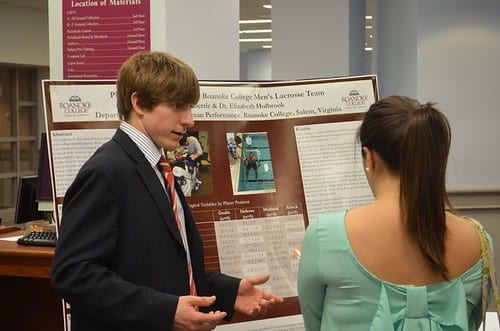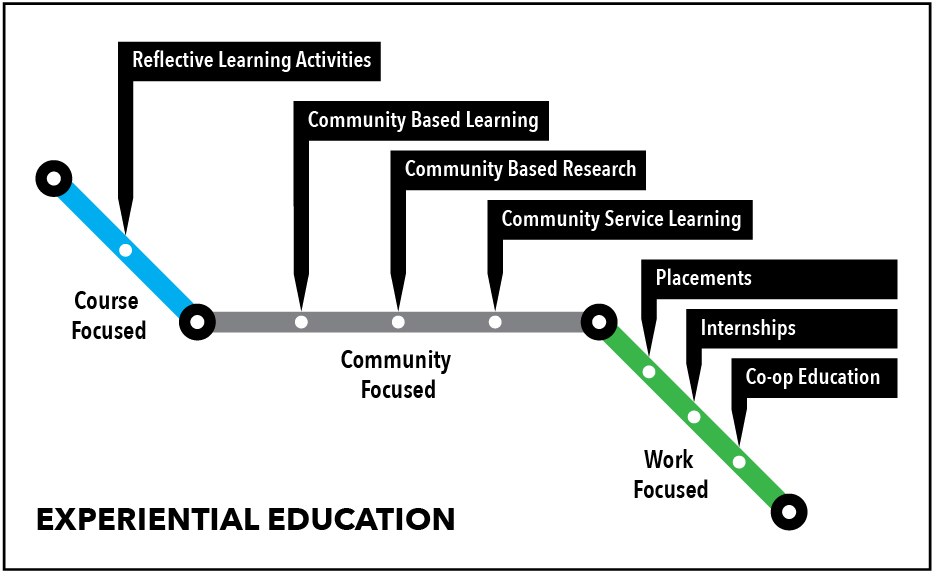The following resources were created and compiled by Kerry Kuenzi, Assistant Professor, Public and Environmental Affairs.
Introduction
Hands-on learning experiences and assignments help students to move beyond memorization and conceptual learning toward deep learning – the process of fusing this earlier type of learning with real-world situations. Although the evidence on learning styles of types of learning is not uncontested, it is apparent that “practicing” skills and concepts can help us to move toward mastery. It’s why you can learn the basics of cooking by watching a cooking show, but can improve your skills through the practice you get in the kitchen!
The benefits to these type of assignments are well-documented in the literature (and are covered further on the next page). Further, UWGB students have found the experiences to be highly valuable.
Speaking about a community-based learning experience, one student in Public and Environmental Affairs noted, “Sometimes you’ll take a class and you can go, ‘What did I learn?’ This is, this is a case where for me at least it solved a big portion of it.”
While these learning experiences are extremely impactful to students, implementing them in an online or blended environment may be challenging especially in reconciling being hands-on while being social distanced.

What is experiential learning? Engaged learning? Deep learning?
Hands-on learning experiences have a variety of different names for closely related but not always equivalent learning experiences. There is not wide agreement on what exactly constitutes each type and how they differ.
Some of the commonly used terms include:
|
|
The terminology as well as the type that is most common or that works best is likely driven by discipline as well as expected course outcomes. Typically, these experiences involve students applying their conceptual knowledge in a real-world context in some capacity. Shared characteristics and key components across types include reflection and big picture/meta-level thinking. These help students bring insights to life, connect theory to practice, see insights within themselves, and help students to make connections in a complex wold to identify their role in it.
A good open resource for more information on experiential learning is the Carleton University’s Experiential Education website. Here is how they distinguish what makes a learning experience experiential:
“Experiential learning is the application of theory and academic content to real-world experiences, either within the classroom, within the community, or within the workplace, which advances program or course-based learning outcomes…
Experiential Education:
- Combines direct experience with focused reflection;
- Builds on past knowledge and experiences;
- Requires active involvement in meaning construction;
- Encourages collaboration and exchange of ideas and perspectives;
- Can be course focused or in-class, community focused, or work focused.”
Rather than engage in the debate to distinguish types, in this resource the term experiential learning will be used to characterize the wide array of experiential educational endeavors.

Photo Credit: Association for Experimental Education
What types of experiences are experiential?
There are a wide range of of activities that would qualify based on the above definition. Using the course-community-work distinction, these experiences can include:

Source: Carleton University’s Experiential Education Website
Why design experiential learning into your courses?
Research on teaching and learning has found that “connect” activities are often associated with higher rates of retention and understanding than absorb or doing activities alone (e.g. Blooms Taxonomy and/or the Learning Pyramid).
Evidence includes:
- Enhancements in student’s academic and life skill development1
- An increased sense of civic responsibility and community participation2
- Increased exposure to new people and ideas3
- An increased ability to understand and solve social problems4
Some types of experiential learning, particularly those designed into regular courses have also been found to increase equity for traditionally underrepresented groups, as many of these students cannot participate in individualized learning experiences such as internships5.
When is experiential learning appropriate and how do I go about designing one of these experiences?
Experiential learning experiences need to be designed carefully and thoughtfully in order for the students to have a meaningful experiences and to achieve desired outcomes. Further, careful design and implementation of experiential learning experiences can be labor intensive for instructors so I encourage thinking about where they best fit will result in better quality (instead of quantity). It cannot be emphasized enough that experiential learning experiences should be designed carefully and thoughtfully. Therefore, a guide of best practices can be found here, Best Practices of Experiential Learning.
Considerations:
- Student population and their needs
- Appropriate activities based on course content
- Potential implementation issues
- Assessment
- Your Role as the Instructor
Importance of reflection in experiential learning
Regardless of the type of experiential activity you design, the level of class, or other considerations, the reflection stage of experiential learning is critical as it the opportunity for students to bridge concepts and experience. Reflection opportunities also foster problem solving and professional development, promotes conscious action and self-awareness, and contributes to deeper understanding of issues.
In reflection activities, the instructor encourages students to critically analyze their experience. Encourage students to reflect as they go but provide an opportunity for a longer, more critical reflection once the experience has been completed. Instructors can provide prompts or questions to the student to get students to consider multiple perspectives or to make connections. Examples of activities include:
|
|
Here is an additional resource, a Guide for Reflection in Your Course, that also includes frameworks for reflection and a list of prompts that can be used to facilitate reflection.
1. Boss, 1994; Kendrick, 1996; Astin & Sax, 1998; Eyler, Giles, Stenson, & Gray, 2001; Ash, Clayton, & Atkinson, 2005; Sherman & MacDonald, 2009
2. Astin & Sax, 1998; Eyler, 2010
3. Jones & Abes; 2004; Fitch, 2005; Lundy, 2007
4. Eyler & Giles, 1999; Pascarella & Terenzini, 2005
5. Cantor, 1995
Tips for adding experiential learning to your class
- You can start small
- Be explicit with your students about your expectations including that they will have to drive some of their learning and that you expect high quality work when engaging with a community partner
- Students may need help connecting the pieces so consider opportunity for them to get feedback and engage in reflection across the semester rather than just at the end
- Have a contingency plan for the unexpected